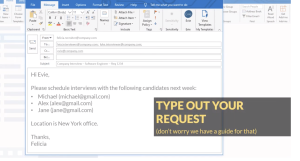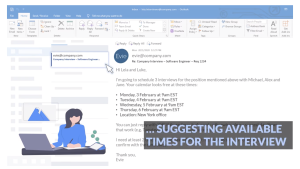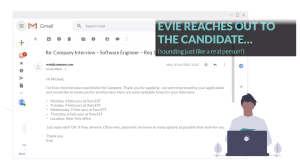Scheduling interviews doesn’t sound like something that should be complicated. And yet all too frequently, it is.
Imagine you want a candidate to have back-to-back interviews with two busy managers – people who sometimes work from different locations.
You prefer to do in-person interviews, but a video call is an option.
Finding the best possible option can be a challenge, but today, when we have a challenge we turn to AI.
Evie AI is a narrow – but deep – AI application focusing on this one problem.
In the past, HR managers might just have treated Evie’s AI as a magic box. I now think HR needs to have an idea about what’s under the hood of AI apps.
Start by understanding what data the AI is ingesting
To understand an AI application, it’s helpful to ask what data the system uses. In the case of interview scheduling, the data is of two distinct types:
- The calendars of those involved in the interviews
- All the rules and preferences around the interview process (such as who needs to be in the interview)
The former is straightforward; the latter requires someone with a detailed understanding of the interviewing process at your organization.
This is probably the person scheduling the interviews manually, and you can imagine it taking some effort for them to clearly articulate the rules and preferences.
It’s these rules and preferences that drive the AI’s decision-making.
How does the AI work?



It’s easy to say that a system has “AI”, however, HR professionals should know just what kind of AI they are using.
The first thing that will occur to you is that the scheduling problem isn’t going to be solved by the sort of pattern-matching machine-learning that you might use to identify good resumes.
Nor is it the sort of thing you can ask an large-language model (LLM ) like ChatGPT to do.
For the task of scheduling interviews, Evie uses yet another form of AI: “symbolic reasoning.”
Symbolic reasoning is what people sometimes call “good old-fashioned AI”.
Symbolic reasoning mimics how humans logically work through problems. It’s easier to make sense of what the AI is doing than with other approaches to AI.
How can I check the output?
When assessing an AI system, it is always a good idea to look at a decision it made, and then ask the vendor if they can explain why it made that choice.
AIs based on LLMs are famous for being a bit mysterious.
LLMs can give advice but struggle to tell you why they gave that advice.
Similarly, a pattern recognition machine learning AI system can tell you it thinks a picture is a kitten, but it can’t tell you why.
With a symbolic reasoning system, you can potentially go right through the logic of why the AI made the decision it did.
This will give you confidence in the AI’s recommendations and allow you to adjust the rules if they are not aligned with your preferences.
Three more notable points
Several other things about Evie are of general interest:
Narrow Domains
Evie can use symbolic reasoning because it is operating in a very specific domain. It doesn’t need to know everything about recruiting, it just needs a deep understanding of how you like to schedule interviews. We can expect to see both narrow and general AI tools from vendors, both have their place.
Integrations
When I asked Jin Hian Lee, the founder of Evie, what the company was working on, he discussed integrations with HRIS, ATS, and other workflows. In the early versions of AI tools you may find they do one thing, but in isolation. As soon as you want these to be used in production then an isolated system won’t do, you need integration and workflows. If you like the magic a given AI tool can do, the next questions to ask will be about how it can be integrated into your existing systems and processes.
The business case is strongest in large companies
One common refrain I hear from AI tools in talent acquisition is that the tools are best suited to large organizations. If you are in a small organization, you may find some AI tools that sound attractive but are not economic at your scale.
The bottom line
Evie is a great example of an AI tool aimed to solve a specific narrow problem.
It’s quite different from the LLMs and pattern-matching machine-learning AI techniques we may have seen in other tools.
The better you understand how these different tools work the more confidence you can have in selecting and using AI in your organization
